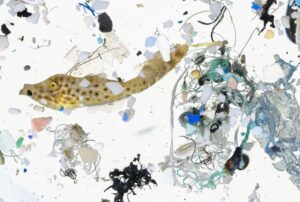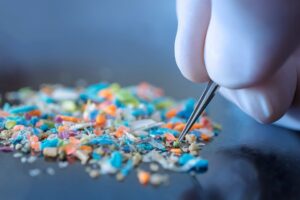People are using plastics every day. From morning to night, we are encountered by plastics. Using brush for tooth cleaning at morning, carrying vegetables, drinking cane, biscuits and clothes packets are mostly composed of plastics. Nowadays, we are unable to escape from plastic garbage. Generally, plastics are not decomposed, some plastics are decomposed but required thousand years. So particles of plastics exist in soil that causes serious impact on soil, some particles are found in environment those inhibit different biological process of life. The plastic particles of with less than five millimeters (0.2 inches) in diameter are called microplastics.
Microplastics are mainly two categories: primary and secondary. Primary microplastics are produced for commercial purpose as cosmetics. Otherwise, secondary microplastics are produced from the breakdown of large plastic items such as juice cane. Microplastics are extremely persistent and are present everywhere from ocean ice to human brains. Microplastics are entered into our body in different way as sources of food. Also accumulating in the environment, it inhibits the general life cycle of living organism. In recent, it is found that microplastics affect the biological process in plant body. A new study published on Monday in the Proceedings of the National Academy of Sciences USA about the effects of microplastics on plants. The study reveals that microplastics inhibit the photosynthesis process, the most important biological process by which plants produce carbohydrate that is the food source of animal kingdom like human being. They found this phenomenon in different types of plants lie food crops.
Microplastics reduce the photosynthesis rate in plant body. The researchers found that presence of microplastics can reduce photosynthesis by as much as 7 to 12 percent. It can be 6 to 18 percent in terrestrial crops, 2 to 12 percent in marine plants and 4 to 14 percent in freshwater algae. It is alarming news for global food system. Because plants are the main primary source of food for world population and other organism under Animalia kingdom. If the photosynthesis process is reduced due to microplastics results less production of primary food in food system.
 The amount of plastic production in the world considering microplastics exposure could see a 4 to 13.5 percent yield loss per year in staple crops such as rice, wheat, corn over the next 25 years. It is really alarming consideration for the world experts. As the growing population, climate change we need to consider with intensive research to produce more food. With this report related to microplastics will be the another issue for consideration of food system, production technology to ensure proper supply of food for the upcoming world.
The amount of plastic production in the world considering microplastics exposure could see a 4 to 13.5 percent yield loss per year in staple crops such as rice, wheat, corn over the next 25 years. It is really alarming consideration for the world experts. As the growing population, climate change we need to consider with intensive research to produce more food. With this report related to microplastics will be the another issue for consideration of food system, production technology to ensure proper supply of food for the upcoming world.
Plants are the crucial part for keeping environmental balance. Plants uptake carbon di oxide from the environment and release oxygen to the environment. Due to decreased photosynthesis could also create new challenge to fight with climate change. Beside this microplastics have been linked with human and animal health issues. They are related with an increase in heart attack and stroke of human being. Also due to microplastics, number of species growth and reproduction can be hampered.
So, it is urgent to develop an international agreement and work together to reduce microplastic production for the sake of our future. A team headed by Richard Thompson from the University of Plymouth in England estimates that reducing the amount of plastics particles by just 13 percent of present status could mitigate photosynthesis loss by 30 percent. Although efforts to develop international agreement on plastic have been underway since 2017, but we need to take proper action to prepare proper plans and apply globally to reduce microplastics to develop a sustainable future to ensure proper food supply.







